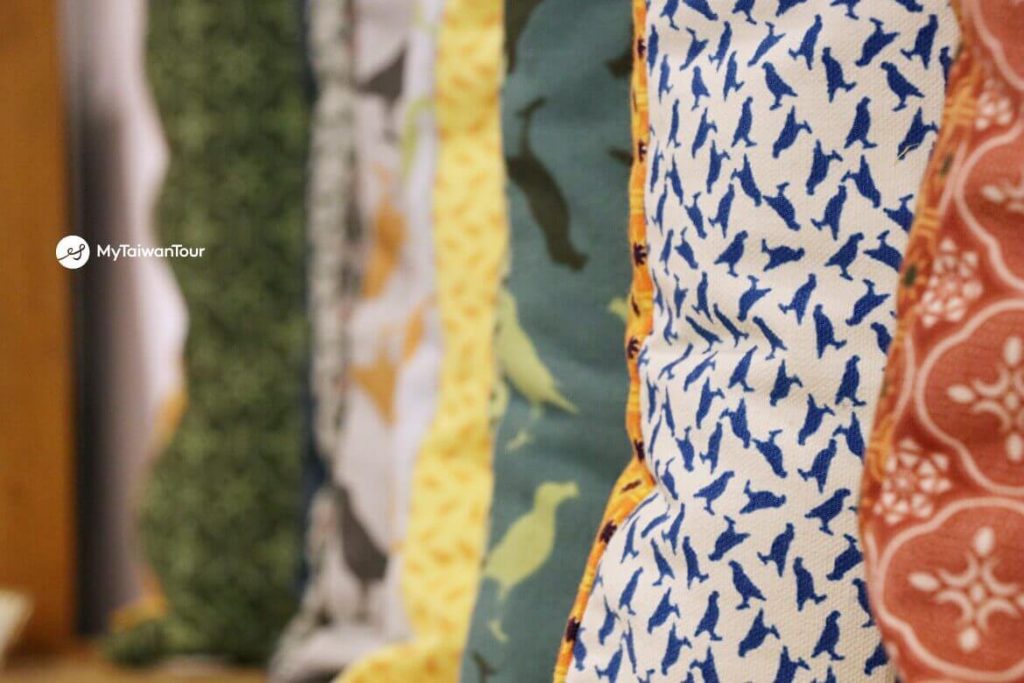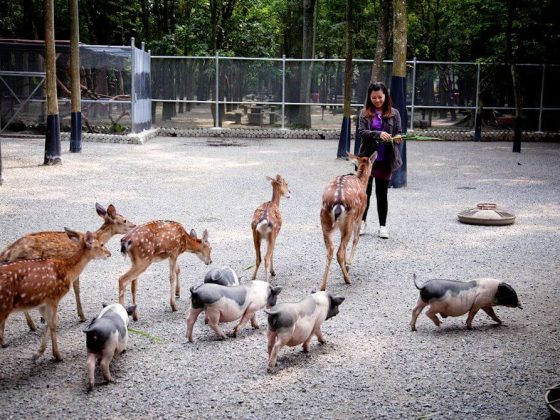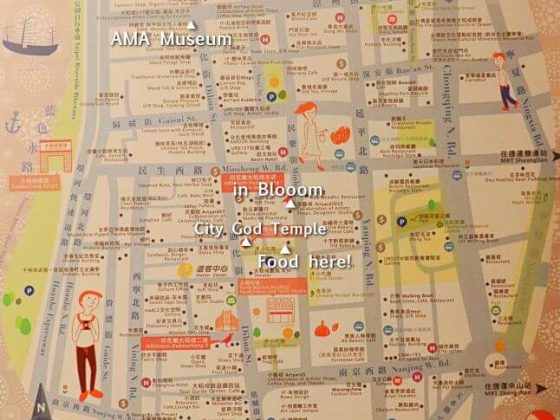Dadaocheng is a busy neighborhood on most days, especially in the weeks leading up to the Lunar New Year holidays. But even on the busiest days things are usually a bit quieter on two blocks west, which is where you’ll find InBlooom, a shop specializing in both selling print goods and in teaching Taiwanese printing art to locals and visitors alike.
Taiwan Scene sat down with InBlooom co-founder Ama Shen to talk about the elusive nature of Taiwanese art and culture, the transformation of the Dadaocheng neighborhood, and the idea of art and culture as tools in Taiwan’s soft power arsenal.
Ama Shen is a slim woman, with a short bobbed hairstyle mildly evoking the style of the flappers in the roaring twenties and the flowing, colorful garments one would expect from someone whose stock in trade is beautiful fabric. But behind her style lies deep questions about what it means to be an artist in twenty first century Taiwan, especially one who’s livelihood straddles the nexus of art, business and national identity. The first question (concerning her brand’s unusual name, which is like the Nirvana song only with an extra “O” she answers quite quickly.
“The store was founded by three women, and of course there was tons of discussion about what we should do with the space. The three O’s are meant to represent three mouths talking.”
But other questions are not so easily answered.
What Is Taiwanese Style?
Ama lets the question hang in the air for a few moments. It’s clearly a question to which she’s given a lot of thought.
“Unlike places like, say, Japan or India, Taiwan doesn’t have an instantly recognizable or iconic style of fabric design or pattern. We are in many ways a hybrid culture, drawing influences from so many other areas – Japanese culture, Chinese culture, Tribal cultures, and of course numerous countries on the west, that it’s difficult to really pinpoint Taiwanese style or Taiwanese art. It gets more complicated when you add historical periods into the question. I try to avoid making distinctions like this or that is definitively Taiwan, or even, this is modern, or that is traditional.”
According to Ama, this breadth of cultural roots makes it easier for Taiwan’s fashion and design community, who face less restrictive choices than counterparts in Japan or Korea might.
“In some ways, we have a blank slate to work with, allowing us more freedom to shape Taiwan’s stories with our designs, imprinting them with images native to Taiwan, or environmental scenes that reflect Taiwan’s uniqueness.”
Ama says that a good part of her inspiration comes from aspects of Taiwan that are truly unique, specifically the Island’s flora and fauna. On one shelf sits a handbag bearing the image of a Formosan Crested Myna.
“There are so many animals only found in Taiwan, but we’re such an urbanized society that most Taiwanese have never seen one personally. As a result, these iconic animals are slowly disappearing from our lives. For me, part of my inspiration is to tell the stories of these creatures. The Formosan Crested Myna is a talking animal, so it felt natural to allow it to tell its own story, and in doing so, reconnect people in cities who might otherwise never come across one in the wild.”
Architecture as a touchstone for design
Like Taiwan’s flora and fauna, its architecture can also be iconic. Ama produces another piece of fabric on which Taipei’s traditional architectural features are prominently printed: An old iron window frame, a traditional ceramic tile. The line work evokes a simpler architectural age, not one of steel and glass, but of brick and mortar.
“Urban renewal is a big topic these days, and the trend seems to be more towards new is better.” Says Ama with a slightly wistful sigh. “I think that we lose some feeling from this philosophy, something more genuine, with newer homes lacking the feeling of some of the older ones. So with our work I try to include many of the older elements that I also find inspiring, both in color and design style.” Ama says that designs based on traditional architecture seem to connect well with people.
“I’ve had customers come in and buy specific designs because various aspects remind them of something from their youth, maybe the pattern of a floor tile or a doorway from their childhood home. It’s not limited to locals, either. A lot of Western visitors have commented that they’ve seen things in our work that are familiar to them, which isn’t surprising. Taiwan is an island culture and a lot of influences find their way to our shores, and these influences find their way into our work. In this way, I find that a lot of my own work defies the label of “traditional” or “modern”, “Taiwanese” or “Western.” As a designer, I think my responsibility is to integrate these aspects, presenting a different, unique point of view.”
 More telling, Ama says, are the moments when one of her designs evokes nostalgia not in a local, but in a Western customer. She shows us a tile mosaic pattern on a sheet of fabric showing a pattern that to most would seem to evoke a design sense more in line with Taiwanese sensibilities from the early twentieth century (when such sensibilities were heavily influenced by Japan).
More telling, Ama says, are the moments when one of her designs evokes nostalgia not in a local, but in a Western customer. She shows us a tile mosaic pattern on a sheet of fabric showing a pattern that to most would seem to evoke a design sense more in line with Taiwanese sensibilities from the early twentieth century (when such sensibilities were heavily influenced by Japan).
“A customer from America came in a while back and bought one of these telling me that it reminded her of something from her hometown in the States as a child. I found this gratifying, as one of the things I want to trigger is a feeling of nostalgia with our art. It’s important to synthesize these things through a personal perspective to answer the question what is Taiwan culture. I think that the fact that an American customer was able to experience this with an object created with a Taiwanese design pattern speaks to Taiwan being a country with many diverse elements and a deeply multicultural background. As for the question of What is Taiwanese Style, well…I don’t think I’ve yet found a decisive answer.”
Art as a form of Soft Power
The discussion turns to the concept of soft power, the use of art and culture to propel a country onto the world stage. For Taiwan, barred by its unique geopolitical circumstances from traditional recognition, this is an especially valuable area of diplomacy. But while various Taiwanese artists have made tremendous impact on the world stage – think Ang Lee, or A-mei – there hasn’t as yet been a Taiwanese equivalent of Korea’s K-Pop phenomenon, or the instantly recognizable Japanese Anime. Initially, Ama says she shied away from what is undoubtedly the heady responsibility of attaching too much of a cultural element to her own designs.
“As we’d discussed earlier, it’s really hard at this point to create a design that screams yes, this is Taiwan in the same way as say, an item of clothing from Thailand, Japan or India might be considered purely representative of those countries. Therefore, we shouldn’t really pursue this kind of iconic design. Instead, I think of design as a more simple thing, something that should bring one pleasure and happiness. Yes, there is definitely the element of promoting culture through design, as in having a Western customer who purchases something from our shop…even if the first reason why they chose the item be for reasons of color, design and pattern…return to their home country and wear the item and gradually come to think of it as being something Taiwanese. In this way, yes, an object of art can become a medium through which people outside of Taiwan can learn about the design and culture of Taiwan.”
The Vitality and Charm of Dadaocheng
Even a few blocks away from the main drag – and a few weeks before the serious people mountain people sea that comes flooding into the area just before the holidays, foot traffic was brisk in the store, with customers walking in browsing every couple of minutes. Ama says that her choice of Dadaocheng as InBlooom’s first location (there are currently four, including a second store in Dadaocheng and a store each in Taichung and Kaohsiung) was no accident. Even six years ago, before the neighborhood had reached peak trendiness, Dadaocheng was her first choice as a place to start. (Read also: Why Dadaocheng should be your first stop in Taipei)
 “Dadaocheng is home to the Yongle Market, Taipei’s oldest fabric market. People have been buying and selling fabric here for generations, and we felt strongly if we were going to brand ourselves as Taiwanese designers we should open our shop in a place that’s best known for cloth and fabric design. And of course, there’s a vitality in Dadaocheng that I just don’t think you’d find in Neihu or Xinyi, and as artists we wanted to tap into that. It’s a really charming neighborhood. When we first opened up we were one of the few new shops in the neighborhood, and frankly some of the older folks in the area thought we were a bit strange for choosing Dadaocheng, questioning why a shop clearly aimed at younger people would open up in a neighborhood more known for traditional items. But we found the neighborhood inspiring, and knew this was where we wanted to be.”
“Dadaocheng is home to the Yongle Market, Taipei’s oldest fabric market. People have been buying and selling fabric here for generations, and we felt strongly if we were going to brand ourselves as Taiwanese designers we should open our shop in a place that’s best known for cloth and fabric design. And of course, there’s a vitality in Dadaocheng that I just don’t think you’d find in Neihu or Xinyi, and as artists we wanted to tap into that. It’s a really charming neighborhood. When we first opened up we were one of the few new shops in the neighborhood, and frankly some of the older folks in the area thought we were a bit strange for choosing Dadaocheng, questioning why a shop clearly aimed at younger people would open up in a neighborhood more known for traditional items. But we found the neighborhood inspiring, and knew this was where we wanted to be.”
Dadaocheng has changed markedly in the six years since Ama and her partners first set up shop, and in 2018 there are no shortage of trendy bars, boutiques and coffee shops, all businesses that generally tend to attract a hipper clientele. This represents, according to Ama, a change in Taiwanese sensibilities.

“Yeah, even a decade ago younger people in Taipei were more drawn to flashy malls than to Dadaocheng, thinking of it as sort of an old fashioned place. But it’s popularity has really increased over the past few years, and I think people are starting to reconsider the value of preservation.”
Not surprisingly, Dadaocheng tops Ama’s must visit list for people looking to truly experience Taipei’s cultural scene, alongside Yongkang Street (“a bit overly commercial since it got it’s own MRT station”) and the Taipei National University of the Arts (“I like to visit their campus…it’s got a great view of the city.”)
[youtube https://www.youtube.com/watch?v=dS0xrnZG0CE]Learn how to make handicrafts in Dadaocheng with InBlooom by joining Vintage Taipei Day Tour or customizing your own experience with MyTaiwanTour now!
More voices from Taiwan: Interview with Hey Taipei Author Kathy Cheng
More on Dadaocheng: 15 suggestions for a day in Dadaocheng

















Comments are closed.